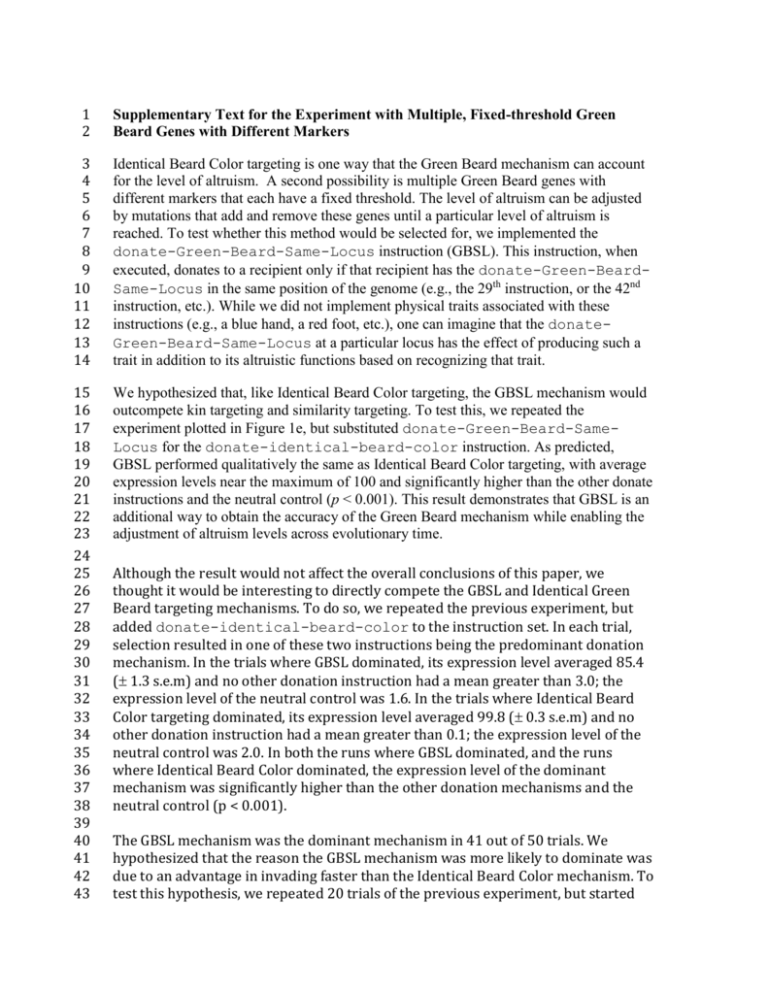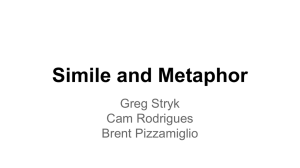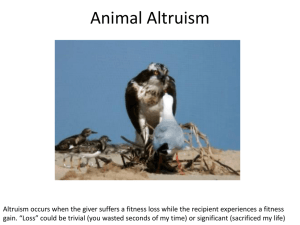Supplementary Text and Figure Caption for Supplementary Figure
advertisement

1 2 Supplementary Text for the Experiment with Multiple, Fixed-threshold Green Beard Genes with Different Markers 3 4 5 6 7 8 9 10 11 12 13 14 Identical Beard Color targeting is one way that the Green Beard mechanism can account for the level of altruism. A second possibility is multiple Green Beard genes with different markers that each have a fixed threshold. The level of altruism can be adjusted by mutations that add and remove these genes until a particular level of altruism is reached. To test whether this method would be selected for, we implemented the donate-Green-Beard-Same-Locus instruction (GBSL). This instruction, when executed, donates to a recipient only if that recipient has the donate-Green-BeardSame-Locus in the same position of the genome (e.g., the 29th instruction, or the 42nd instruction, etc.). While we did not implement physical traits associated with these instructions (e.g., a blue hand, a red foot, etc.), one can imagine that the donateGreen-Beard-Same-Locus at a particular locus has the effect of producing such a trait in addition to its altruistic functions based on recognizing that trait. 15 16 17 18 19 20 21 22 23 24 25 26 27 28 29 30 31 32 33 34 35 36 37 38 39 40 41 42 43 We hypothesized that, like Identical Beard Color targeting, the GBSL mechanism would outcompete kin targeting and similarity targeting. To test this, we repeated the experiment plotted in Figure 1e, but substituted donate-Green-Beard-SameLocus for the donate-identical-beard-color instruction. As predicted, GBSL performed qualitatively the same as Identical Beard Color targeting, with average expression levels near the maximum of 100 and significantly higher than the other donate instructions and the neutral control (p < 0.001). This result demonstrates that GBSL is an additional way to obtain the accuracy of the Green Beard mechanism while enabling the adjustment of altruism levels across evolutionary time. Although the result would not affect the overall conclusions of this paper, we thought it would be interesting to directly compete the GBSL and Identical Green Beard targeting mechanisms. To do so, we repeated the previous experiment, but added donate-identical-beard-color to the instruction set. In each trial, selection resulted in one of these two instructions being the predominant donation mechanism. In the trials where GBSL dominated, its expression level averaged 85.4 ( 1.3 s.e.m) and no other donation instruction had a mean greater than 3.0; the expression level of the neutral control was 1.6. In the trials where Identical Beard Color targeting dominated, its expression level averaged 99.8 ( 0.3 s.e.m) and no other donation instruction had a mean greater than 0.1; the expression level of the neutral control was 2.0. In both the runs where GBSL dominated, and the runs where Identical Beard Color dominated, the expression level of the dominant mechanism was significantly higher than the other donation mechanisms and the neutral control (p < 0.001). The GBSL mechanism was the dominant mechanism in 41 out of 50 trials. We hypothesized that the reason the GBSL mechanism was more likely to dominate was due to an advantage in invading faster than the Identical Beard Color mechanism. To test this hypothesis, we repeated 20 trials of the previous experiment, but started 44 45 46 47 48 49 50 51 52 53 54 55 56 with a population of organisms that executed donate-identical-beardcolor 100 times. In all 20 trials, the final evolved genotypes retained the Identical Beard Color mechanism as dominant. We repeated this experiment, but seeded the population with organisms that performed donate-Green-Beard-Same-Locus 100 times. In this case, the GBSL mechanism remained dominant in all 20 trials. These two experiments show that Identical Beard Color targeting does not invade GBSL and vice versa. Overall, the experiments competing GBSL with Identical Beard Color targeting suggest that GBSL and Identical Beard Color targeting are two different, roughly equivalent means to accurately target altruism (via the Green Beard mechanism) and account for altruism levels (and the need to adjust them across evolutionary time). 57 58 59 Supplementary Figure 1 – An illustration of the effect of including altruism levels as part of the concept of accuracy 60 Circles W, X, Y, and Z represent organisms with varying levels of altruism. Specifically, 61 W, X, and Y are altruistic (indicated by allele A) and Z is not (indicated by allele a). The 62 number to the right of the allele indicates the altruism level, or number of donations each 63 hypothetical organism performs (e.g., A3 indicates 3 donations performed). If accuracy is 64 not considered when targeting altruism, W would donate to both X and Y. However, if 65 altruism levels are considered when targeting altruism, via a discrimination level that 66 mandates that altruism recipients have a minimum altruism level (here, 3), W will donate 67 to X, but not to Y. 68







